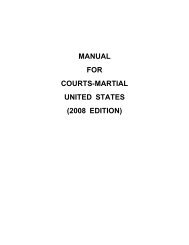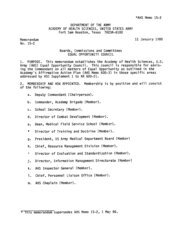09 29_11.pdf - Fort Sam Houston - U.S. Army
09 29_11.pdf - Fort Sam Houston - U.S. Army
09 29_11.pdf - Fort Sam Houston - U.S. Army
You also want an ePaper? Increase the reach of your titles
YUMPU automatically turns print PDFs into web optimized ePapers that Google loves.
PAGE 6 NEWS LEADER SEPTEMBER <strong>29</strong>, 2011<br />
Innovative pain techniques taught at tri-service ultrasound course<br />
By Capt. (Dr.) John Gasko<br />
<strong>Army</strong> Medical Department Center<br />
& School<br />
<strong>Army</strong>, Air Force and<br />
Navy certified registered<br />
nurse anesthetists<br />
recently learned new and<br />
innovative techniques using<br />
ultrasound for regional<br />
pain management.<br />
The techniques were<br />
taught during the “Ultrasound<br />
Guided Nerve<br />
Block Course for Anesthesia<br />
Providers,” a<br />
course offered through<br />
the U.S. <strong>Army</strong> Graduate<br />
Program in Anesthesia<br />
Nursing at the <strong>Army</strong><br />
Medical Department Center<br />
& School.<br />
The anesthesia nursing<br />
program is rated nationally<br />
as number one in its<br />
field by U.S. News & World<br />
Report and AMEDDC&S is<br />
one of two military schools<br />
that produce military<br />
certified registered nurse<br />
anesthetists.<br />
The graduate program<br />
also sponsors continuing<br />
education workshops<br />
to promote continuing<br />
education for all military<br />
anesthesia providers.<br />
Acquisition of ultrasound-guided<br />
regional<br />
skills for nurse anesthetists<br />
and the effects of<br />
battlefield anesthesia on<br />
long-term pain management<br />
are among the<br />
leading research priorities<br />
for <strong>Army</strong> nurse<br />
anesthesia researchers,<br />
according to the <strong>Army</strong><br />
Nursing Research and<br />
Evidence Based Practice<br />
Priorities list.<br />
This course addresses<br />
all three topics and allows<br />
the program to play<br />
a direct role in the education<br />
of nurse anesthesia<br />
providers.<br />
Among many professionals,<br />
the use of ultrasound<br />
for image guidance<br />
in regional anesthesia is<br />
anticipated to become a<br />
standard of care.<br />
“Anesthesia providers<br />
agree that direct visualization<br />
of internal structures<br />
may lead to safer, quicker,<br />
and more successful<br />
blocks with fewer complications,”<br />
said Lt. Col. Joseph<br />
O’Sullivan, USAGPAN<br />
program director.<br />
Photo by Capt. (Dr.) John Gasko<br />
<strong>Army</strong> Reserve Col. Colleen Kloehn (right) scans classmate Navy<br />
Cmdr. Robert Ladd, chief nurse anesthetist, Ft Belvoir, Va., during<br />
the Ultrasound Guided Nerve Block Course for Anesthesia Providers<br />
Course.<br />
The course focused<br />
on the principles of the<br />
ultrasound machine and<br />
upper and lower extremity<br />
anatomy and blocks.<br />
Participants from various<br />
<strong>Army</strong>, Air Force and<br />
Navy medical treatment<br />
facilities performed<br />
blocks on cadavers<br />
supplied by the graduate<br />
program during the<br />
course.<br />
A follow-on discussion<br />
session gave providers an<br />
opportunity to share experiences<br />
and anecdotal<br />
input. Topics included increased<br />
effectiveness and<br />
decreased incidence of<br />
complications associated<br />
with ultrasound guided<br />
regional anesthesia.<br />
“The primary goal<br />
of this course was to<br />
ensure that all anesthesia<br />
providers have the skill<br />
sets necessary to provide<br />
the best care for Soldiers<br />
downrange,” O’Sullivan<br />
said.<br />
“This course was great<br />
for me. I’ve done the<br />
trauma rotation in Baltimore<br />
but we didn’t get<br />
the regional ultrasound<br />
focus like we did here,”<br />
said Capt. Jeff Gainok,<br />
274th Forward Surgical<br />
Team (Airborne), <strong>Fort</strong><br />
Bragg, N.C.<br />
“I was already pretty<br />
familiar with ultrasound<br />
guided regional from<br />
school but being able to<br />
get the hands-on and<br />
one-on-one instruction<br />
was definitely beneficial,”<br />
Gainok added.<br />
“This course allowed<br />
attendees to augment<br />
their knowledge and experiences<br />
with ultrasound<br />
and anatomy,” said Dr.<br />
Justin Boge, an anesthesiologist<br />
at Wilford Hall<br />
Medical Center, Lackland<br />
Air Force Base, who also<br />
taught and attended the<br />
course.<br />
“These opportunities<br />
allow the clinicians to<br />
return to their medical<br />
treatment facilities<br />
and share their knowledge<br />
and information<br />
learned and disseminated<br />
throughout the course,”<br />
Boge added. “This provides<br />
an immeasurable<br />
impact on the military’s<br />
mission to provide worldclass<br />
healthcare.”<br />
Participants have<br />
enrolled from as far<br />
away as Hawaii while<br />
some are attached to U.S.<br />
<strong>Army</strong> Forces Command<br />
positions, although most<br />
are from major military<br />
medical centers.<br />
“We continue to use<br />
the team approach in<br />
caring for Soldiers, families<br />
and retired members<br />
of our armed services,”<br />
O’Sullivan said, adding<br />
that faculty felt it so important<br />
they volunteered<br />
their time to instruct.<br />
The course provided<br />
14 continuing education<br />
credits for professional<br />
certification and is<br />
planned to be an annual<br />
event.
















